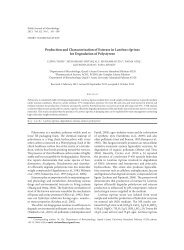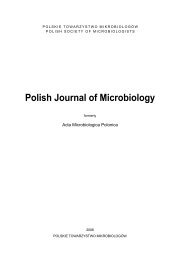No 3 - Polish Journal of Microbiology
No 3 - Polish Journal of Microbiology
No 3 - Polish Journal of Microbiology
You also want an ePaper? Increase the reach of your titles
YUMPU automatically turns print PDFs into web optimized ePapers that Google loves.
196<br />
We detected differences in phage content within single<br />
emm/ST groups that was reflected in described previously<br />
subtype <strong>of</strong> PFGE (Fig. 3). Although PFGE subtyping<br />
is the best predictor <strong>of</strong> phage content (WC PFGE→PP =<br />
0.986; CI 95% 0.974–0.997), conversely, PP typing can<br />
detect variants that reflect PFGE subtypes with over<br />
85% probablity (WC PP→PFGE =0.858; CI 95% 0.703–1.000)<br />
(Table VB).<br />
Detection <strong>of</strong> virulence factors. Multiple virulence<br />
factors produced by GAS such as superantigens, proteases<br />
and dNAses are linked to disease severity and<br />
clinical manifestations <strong>of</strong> infection (Bernal et al., 1999;<br />
Borek A.L. et al. 3<br />
Fig. 3A.<br />
Fraser et al., 2000; Pr<strong>of</strong>t et al., 2000). In particular, presence<br />
<strong>of</strong> speA gene is associated with streptococcal toxic<br />
like shock syndrome and scarlet fever (Hauser et al.,<br />
1991; Musser et al., 1991; Stevens et al., 1989; Yu and<br />
Ferretti, 1989) and smeZ participates in repression <strong>of</strong><br />
cognate anti-streptococcal responses (Unnikrishnan<br />
et al., 2002). Therefore, the detection <strong>of</strong> virulence factors<br />
can be used as a predictor <strong>of</strong> disease severity and<br />
as a diagnostic marker.<br />
We designed set <strong>of</strong> four, low volume, multiplex<br />
reac tions that allow simultaneous detection <strong>of</strong> 20 GAS<br />
virulence factors. Two multiplex reactions detect genes






